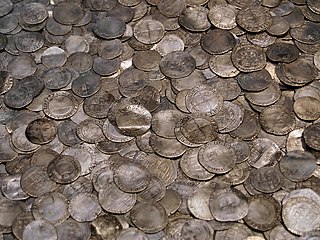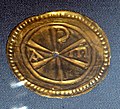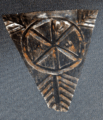
The British Museum is a public museum dedicated to human history, art and culture located in the Bloomsbury area of London. Its permanent collection of eight million works is the largest in the world. It documents the story of human culture from its beginnings to the present. The British Museum was the first public national museum to cover all fields of knowledge.

The Mildenhall Treasure is a large hoard of 34 masterpieces of Roman silver tableware from the fourth century AD, and by far the most valuable Roman objects artistically and by weight of bullion in Britain. It was found at West Row, near Mildenhall, Suffolk, in 1942. It consists of over thirty items and includes the Great Dish which weighs over 8 kg (18 lb).

A hoard or "wealth deposit" is an archaeological term for a collection of valuable objects or artifacts, sometimes purposely buried in the ground, in which case it is sometimes also known as a cache. This would usually be with the intention of later recovery by the hoarder; hoarders sometimes died or were unable to return for other reasons before retrieving the hoard, and these surviving hoards might then be uncovered much later by metal detector hobbyists, members of the public, and archaeologists.
Senuna was a Celtic goddess worshipped in Roman Britain. She was unknown until a cache of 26 votive offerings to her were discovered in 2002 in an undisclosed field at Ashwell End in Hertfordshire by metal detectorist Alan Meek. Her imagery shows evidence of syncretism between a pre-Roman goddess with the Roman Minerva.

Water Newton is a village and civil parish in Cambridgeshire, England. Water Newton lies approximately 5 miles (8 km) west of Peterborough. Water Newton is situated within Huntingdonshire which is a non-metropolitan district of Cambridgeshire as well as being a historic county of England. As the population of the village was 88 only at the 2011 Census it is included in the civil parish of Chesterton.

The Ziwiye hoard is a treasure hoard containing gold, silver, and ivory objects, also including a few gold pieces with the shape of human face, that was uncovered on in Ziwiyeh plat near Saqqez city in Kurdistan Province, Iran, in 1947.


The Oxus treasure is a collection of about 180 surviving pieces of metalwork in gold and silver, most relatively small, and around 200 coins, from the Achaemenid Persian period which were found by the Oxus river about 1877–1880. The exact place and date of the find remain unclear, but is often proposed as being near Kobadiyan. It is likely that many other pieces from the hoard were melted down for bullion; early reports suggest there were originally some 1500 coins, and mention types of metalwork that are not among the surviving pieces. The metalwork is believed to date from the sixth to fourth centuries BC, but the coins show a greater range, with some of those believed to belong to the treasure coming from around 200 BC. The most likely origin for the treasure is that it belonged to a temple, where votive offerings were deposited over a long period. How it came to be deposited is unknown.

The Broighter Gold or more correctly, the Broighter Hoard, is a hoard of gold artefacts from the Iron Age of the 1st century BC that were found in 1896 by Tom Nicholl and James Morrow on farmland near Limavady, Ireland. The hoard includes a 7-inch-long (18 cm) gold boat, a gold torc and bowl and some other jewellery.

The Berthouville treasure is a hoard of Roman silver uncovered by ploughing in March 1830 at the hamlet of Villeret in the commune of Berthouville in the Eure département of Normandy, northern France. Purchased at the time of discovery for a modest 15,000 francs, the treasure is conserved in the Cabinet des Médailles at the Bibliothèque nationale, Paris.



The Sutton Hoo purse-lid is one of the major objects excavated from the Anglo-Saxon royal burial-ground at Sutton Hoo in Suffolk, England. The site contains a collection of burial mounds, of which much the most significant is the undisturbed ship burial in Mound 1 containing very rich grave goods including the purse-lid. The person buried in Mound 1 is usually thought to have been Rædwald, King of East Anglia, who died around 624. The purse-lid is considered to be "one of the most remarkable creations of the early medieval period." About seven and a half inches long, it is decorated with beautiful ornament in gold and garnet cloisonné enamel, and was undoubtedly a symbol of great wealth and status. In 2017 the purse-lid was on display at the British Museum.


The Esquiline Treasure is an ancient Roman silver treasure that was found in 1793 on the Esquiline Hill in Rome. The hoard is considered an important example of late antique silver work from the 4th century AD, probably about 380 for the major pieces. Since 1866, 57 objects, representing the great majority of the treasure, have been in the British Museum.

The Carthage Treasure is a Roman silver hoard, which was found in Tunis, Tunisia, at the site of the ancient city of Carthage. The treasure principally consists of silver tableware and jewellery, most of which is now held at the British Museum.

The Lampsacus Treasure or Lapseki Treasure is the name of an important early Byzantine silver hoard found near the town of Lapseki in modern-day Turkey. Most of the hoard is now in the British Museum's collection, although a few items can be found in museums in Paris and Istanbul too.
The Traprain Law treasure is a hoard of late Roman hacksilver, found on the hillfort of Traprain Law during excavations in 1919. It is the largest hoard of Roman hacksilver currently known, weighing just over 23 kg. It consists mostly of Roman silver vessels, a few of which are complete but most of which had been cut into fragments or crushed. There are a few items of personal equipment and coins. The hoard was probably buried in the early fifth century AD. Early interpretations saw it as loot; more recent views prefer to see it as diplomatic gifts or payment for military service. It is currently on display in the National Museum of Scotland in Edinburgh.

The Treasure of Begram or Begram Hoard is a group of artifacts from the 1st-2nd century CE discovered in the area of Begram, Afghanistan. The French Archaeological Delegation in Afghanistan (DAFA) conducted excavations at the site between 1936 and 1940, uncovering two walled-up strongrooms, Room 10 and Room 13. Inside, a large number of bronze, alabaster, glass, coins, and ivory objects, along with remains of furniture and Chinese lacquer bowls, were unearthed. Some of the furniture was arranged along walls, other pieces stacked or facing each other. In particular, a high percentage of the few survivals of Greco-Roman enamelled glass come from this discovery.























